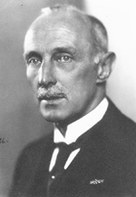You can help expand this article with text translated from the corresponding article in German. (April 2022) Click for important translation instructions.
|

Jan van der Hoeve (13 April 1878 in Santpoort – 26 April 1952 in Leiden) was a Dutch ophthalmologist. He is recognised for his concept of the phakomatoses, often called neurocutaneous syndromes.
Van der Hoeve graduated from the University of Leiden and received his doctorate at the University of Bern. He became a professor of ophthalmology at the University of Groningen and later at the University of Leiden. Van der Hoeve became a member of the Royal Netherlands Academy of Arts and Sciences in 1923. He was elected president of the Physical Section of the institute in 1932.
Van der Hoeve made one of the earliest descriptions of Waardenburg syndrome, in 1916.
Papers
- Van der Hoeve J (1920). "Eye symptoms in tuberous sclerosis of the brain". Trans Ophthalmol Soc UK. 40: 329–334.
See also
References
- "J. van der Hoeve (1878 - 1952)". Royal Netherlands Academy of Arts and Sciences. Retrieved 18 July 2015.
- Song, J.; Feng, Y.; Acke, F. R.; Coucke, P.; Vleminckx, K.; Dhooge, I. J. (2016). "Hearing loss in Waardenburg syndrome: a systematic review". Clinical Genetics. 89 (4): 416–425. doi:10.1111/cge.12631. ISSN 1399-0004. PMID 26100139. S2CID 23834634.
- Enersen, Ole Daniel. "Jan van der Hoeve". Who Named It?. Retrieved 2007-07-13.
This biographical article related to medicine in the Netherlands is a stub. You can help Misplaced Pages by expanding it. |
- 1878 births
- 1952 deaths
- Dutch ophthalmologists
- Leiden University alumni
- University of Bern alumni
- Academic staff of the University of Groningen
- Academic staff of Leiden University
- People from Velsen
- Members of the Royal Netherlands Academy of Arts and Sciences
- European medical biography stubs
- Dutch scientist stubs